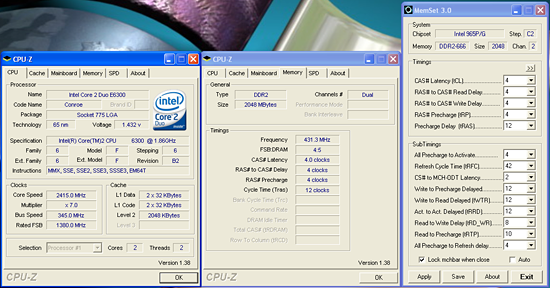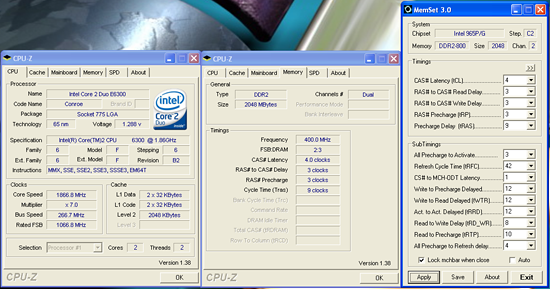Intel P965: MSI P965 Platinum and ECS PX1 Extreme
by Gary Key on December 6, 2006 4:30 AM EST- Posted in
- Motherboards
FSB Overclocking Results
We were able to reach a final benchmark stable setting of 7x345FSB resulting in a clock speed of 2415MHz. This result is a vast improvement over the second BIOS release that limited us to a 305MHz speed. We also had severe compatibility issues with our memory choices during overclocking as CAS3 operation was impossible to maintain even at stock speeds. We had to increase our CPU voltage to 1.425V for this minimal overclock as the board was not stable without it. This CPU normally requires about 1.350V at this speed for stability in other boards.
Memory Stress Testing
We will take a look at how well our GEIL PC2-6400 memory operates in our PX1 board in both two and four DIMM testing. The screenshot above shows the actual memory settings used in our benchmark tests of the board. We do not modify the memory timings beyond the four major settings in our charts. The balance of the settings is implemented automatically via the BIOS and is fairly relaxed on this board. The BIOS only officially supports DDR2 memory speeds of 533/667/800 so anything over 800 is actually overclocking and our results indicate this fact.
We were able to set our timings to 4-3-3-9 by increasing the memory voltage to the maximum 2.15V with our GEIL memory. We were able to hold these timings up to DDR2-810 on this board and held timings of 4-4-4-12 up to DDR2-832 which was our maximum memory overclock. We found that only certain DDR2-800 memory that was capable of CAS 3 settings in the SPD would run at the 4-3-3-9 settings. Otherwise, most mid-level or budget priced DDR2-667 or DDR2-800 memory would only run at their SPD settings of 4-4-4-12 or 5-5-5-15 as an example. We feel like 4-4-4-12 settings should offer the best blend of performance and compatibility with the current BIOS in a 2GB configuration if the BIOS "likes" the memory. Otherwise, your best choice is to buy the least expensive officially rated DDR2-800 memory for this board as even with relaxed timings of 5-5-5-12 the board still performs within a couple of percent of the 4-3-3-9 settings.
Our settings of 4-4-4-12 at 2.15V were stable but did not offer any real overclocking headroom. We were able to keep this setting up to DDR2-810 before switching over to 5-4-4-12 settings that held stable up to our final overclock setting of 7x345, 2415MHz DDR2-832, with four DIMMS installed. Once again, with midrange memory our best four DIMM capability was 5-5-5-12 at 2.15V up to the maximum DDR2-832 rate when overclocking.
| ECS PX1 Extreme Overclocking Testbed |
|
| Processor: | Intel Core 2 Duo E6300 Dual Core, 1.86GHz, 2MB Unified Cache 1066FSB, 7x Multiplier |
| CPU Voltage: | 1.425V (default 1.3250V) |
| Cooling: | Scythe Infinity Air Cooling |
| Power Supply: | OCZ GameXStream 700W |
| Memory: | Geil PC2-6400 800MHz Plus (2x1GB - GX22GB6400PDC) (Micron Memory Chips) |
| Video Cards: | 1 x MSI X1950XTX |
| Hard Drive: | Seagate 320GB 7200RPM SATA2 16MB Buffer |
| Case: | Cooler Master CM Stacker 830 |
| Maximum CPU OC: | 345x7 (4-4-4-12, 4:5, 2.15V), CPU 1.425V, C2 Stepping 2415MHz (+29%) |
| . | |
 |
| Click to enlarge |
We were able to reach a final benchmark stable setting of 7x345FSB resulting in a clock speed of 2415MHz. This result is a vast improvement over the second BIOS release that limited us to a 305MHz speed. We also had severe compatibility issues with our memory choices during overclocking as CAS3 operation was impossible to maintain even at stock speeds. We had to increase our CPU voltage to 1.425V for this minimal overclock as the board was not stable without it. This CPU normally requires about 1.350V at this speed for stability in other boards.
Memory Stress Testing
 |
| Click to enlarge |
We will take a look at how well our GEIL PC2-6400 memory operates in our PX1 board in both two and four DIMM testing. The screenshot above shows the actual memory settings used in our benchmark tests of the board. We do not modify the memory timings beyond the four major settings in our charts. The balance of the settings is implemented automatically via the BIOS and is fairly relaxed on this board. The BIOS only officially supports DDR2 memory speeds of 533/667/800 so anything over 800 is actually overclocking and our results indicate this fact.
| ECS PX1 Extreme Stable DDR2-800 Timings - 2 DIMMs (2/4 slots populated - 1 Dual-Channel Bank) |
|
| Clock Speed: | 800MHz |
| CAS Latency: | 4 |
| RAS to CAS Delay: | 3 |
| RAS Precharge: | 3 |
| RAS Cycle Time: | 9 |
| Voltage: | 2.15V |
We were able to set our timings to 4-3-3-9 by increasing the memory voltage to the maximum 2.15V with our GEIL memory. We were able to hold these timings up to DDR2-810 on this board and held timings of 4-4-4-12 up to DDR2-832 which was our maximum memory overclock. We found that only certain DDR2-800 memory that was capable of CAS 3 settings in the SPD would run at the 4-3-3-9 settings. Otherwise, most mid-level or budget priced DDR2-667 or DDR2-800 memory would only run at their SPD settings of 4-4-4-12 or 5-5-5-15 as an example. We feel like 4-4-4-12 settings should offer the best blend of performance and compatibility with the current BIOS in a 2GB configuration if the BIOS "likes" the memory. Otherwise, your best choice is to buy the least expensive officially rated DDR2-800 memory for this board as even with relaxed timings of 5-5-5-12 the board still performs within a couple of percent of the 4-3-3-9 settings.
| ECS PX1 Extreme Stable DDR2-800 Timings - 4 DIMMs (4/4 slots populated - 2 Dual-Channel Bank) |
|
| Clock Speed: | 800MHz |
| CAS Latency: | 4 |
| RAS to CAS Delay: | 4 |
| RAS Precharge: | 4 |
| RAS Cycle Time: | 12 |
| Voltage: | 2.15V |
Our settings of 4-4-4-12 at 2.15V were stable but did not offer any real overclocking headroom. We were able to keep this setting up to DDR2-810 before switching over to 5-4-4-12 settings that held stable up to our final overclock setting of 7x345, 2415MHz DDR2-832, with four DIMMS installed. Once again, with midrange memory our best four DIMM capability was 5-5-5-12 at 2.15V up to the maximum DDR2-832 rate when overclocking.










13 Comments
View All Comments
mostlyprudent - Wednesday, December 6, 2006 - link
I had been looking forward to the review of the MSI board. I can understand some OC limitation at the price, but then don't call it a "Platinum" board. I really don't do very much OCing, but always view the ability to reach high overclocks as a sign of a more well engineered board.Anyway, thanks for the review.
Beachspree - Monday, December 11, 2006 - link
I was wondering why the Firewire performance is so poor in these reviews:Firewire 400 gets a best throughput of 230.6Mb/s
It is known that Macs have poor USB 2 performance but look at the Firewire results by Barefeats:
http://www.barefeats.com/usb2.html">http://www.barefeats.com/usb2.html
http://www.barefeats.com/hard70.html">http://www.barefeats.com/hard70.html
Without the perfect conditions of a RAM disk and no cacheing they get real world performance of up to:
Firewire 400: 304 Mb/s (31% faster)
Firewire 800: 464 Mb/s (41% faster)
For comparison, Macs are getting lousy USB 2 performance. Intel Macs have improved it but that takes it from around 136Mb/s to 168Mb/s. That's 75% slower.
Given the importance of Firewire in critical multimedia applications and it's likely use for HD video camcorders does this poor performance not warrant a mention?
Beachspree - Monday, December 11, 2006 - link
To be clearer:Can we please have some real world figures for USB 2.0, eSATA and Firewire 400/800 transfers?
That should take the form of transfers of:
a) Many small files
b) One large file
under default settings and off an internal 7200 HDD you standardize on. That's what most people actually do when the backup, so that's what we need to see in order to make informed choices. I suspect these data rates you keep publishing are ones we will actually never see.
I suggest, also, that poor Firewire performance in Windows is more important than poor USB on Macs. They always have Firewire built in and tend to it on peripherals, while Windows users often make do with USB until they get into music or video editing when they then find the need for Firewire and hit this poor performance just when they start needing mission critical performance. I'm talking about dropped frames and music latency.
Why is that ignored in all your motherboard reviews?
Thanks.